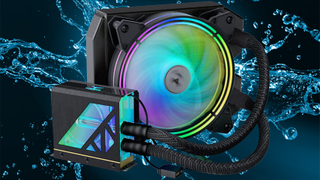TeamGroup Announces SSD with Dedicated AIO Liquid Cooling
Fancy look coupled with extreme performance.

TeamGroup has introduced its new family of SSDs that are equipped with a dedicated all-in-one liquid cooling system (LCS). The T-Force Cardea Liquid II drives will be aimed at hardcore enthusiasts who demand maximum performance and an extreme, but fancy, addition to their rigs.
The T-Force Cardea Liquid II is in development, so TeamGroup hasn't shared any specifications or performance stats just yet. But it is evident from TeamGroup's images that we are dealing with a standard M.2 2280 SSD, presumably with a PCIe x4 interface. Assuming that we are dealing with a PCIe 4.0 x4 bus, performance of this SSD will likely top at 7,400 MB/s, so the key advantage brought by the sophisticated cooling system will be sustained performance over prolonged periods, which not all M.2 drives can offer.
A dedicated liquid cooling system is meant to maximize cooling efficiency and ensure that the drive operates without throttling even under prolonged high loads. Such workloads are pretty rare on desktops, but since there are professionals who run workstation applications on their desktops at home, they could certainly take advantage of advanced cooling for their SSDs.
While a closed-loop LCS may seem like an overkill for a modern consumer-grade PCIe Gen 4 SSD (even the best and the fastest SSD), it may actually be useful for next-generation PCIe Gen 5 drives, as those SSD controllers can dissipate about 9W, so expect SSDs to be even hotter than that.
Meanwhile, SSDs that are designed for persistently high performance also need to provide decent endurance and in many cases, this is something that modern consumer-grade drives rarely offer these days.
But the massive dedicated liquid cooling system for an M.2 SSD may not be ideal for all systems. Many motherboards place M.2 slots near PCIe x16 slots for graphics cards that have rather massive cooling systems. Of course, LCS enthusiasts who would use a liquid-cooled SSD almost certainly use liquid cooling for graphics cards, but there are boards with hybrid cooling systems that feature dual-slot radiators which prevent installation of massive coolers on SSDs.
In any cases, TeamGroup's T-Force Cardea Liquid II drives are still in development, so it remains to be seen how the final drives will look and perform.
Stay on the Cutting Edge
Join the experts who read Tom's Hardware for the inside track on enthusiast PC tech news — and have for over 25 years. We'll send breaking news and in-depth reviews of CPUs, GPUs, AI, maker hardware and more straight to your inbox.

Anton Shilov is a Freelance News Writer at Tom’s Hardware US. Over the past couple of decades, he has covered everything from CPUs and GPUs to supercomputers and from modern process technologies and latest fab tools to high-tech industry trends.
-
Howardohyea interesting SSD, but if you're after sustained performance, I'd rather invest in an Intel Optane drives. Plus didn't Corsair make some SSD waterblocks already? I know this is an actual AiO but this is totally overkill.Reply -
Moonub I love this trend to everything coming with its own inbuilt AIO. The top GPUs are doing it and performing well. Let’s do everything! I’m dreaming of my rig using AIOs for CPU, GPU, SSD - let’s do the RAM too!Reply -
Reply
Well, modern M.2 SSDs do get pretty hot, which is starting to affect their sustained performance. And since the GPU is usually directly above, it's easier to cool the SSD with water cooling than with air when your mainboard doesn't have "M.2 heat shields". Also, not everyone feels confident building their own custom loop, so an AiO solution does make sense.Howardohyea said:I know this is an actual AiO but this is totally overkill.
I do agree it's overkill, though. -
hotaru251 question is...where are you putting that rad?Reply
front and top generally used for cpu/gpu.
the back would be questionable as thickness of it would interfere with stuff i imagine. -
hotaru.hino Reply
We can dunk our hardware in some electrically inert fluid. It's too bad that some patent troll has an overreaching patent on the idea and refuses to do anything but sue the pants out of anyone who tries it without paying them monies.Moonub said:I love this trend to everything coming with its own inbuilt AIO. The top GPUs are doing it and performing well. Let’s do everything! I’m dreaming of my rig using AIOs for CPU, GPU, SSD - let’s do the RAM too! -
Phaaze88 Can we NOT put an AIO on everything and instead leave it to cpus and gpus to help keep the e-waste down?Reply
No?
How about making them serviceable? Alphacool still does it with theirs.
No?
:cautious: -
maestro0428 This is stupid. The stress it puts on that thin connection would be ridiculous. Id take an Optane over this any day of the week.Reply
Most Popular






